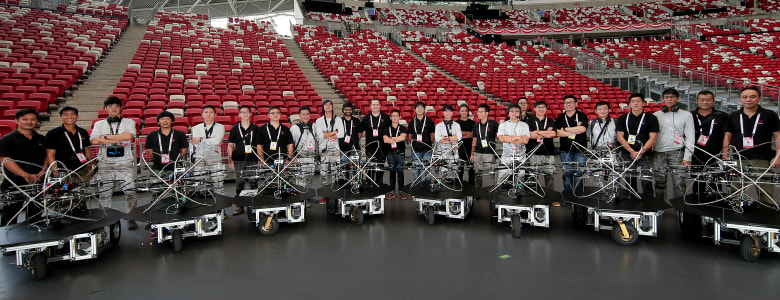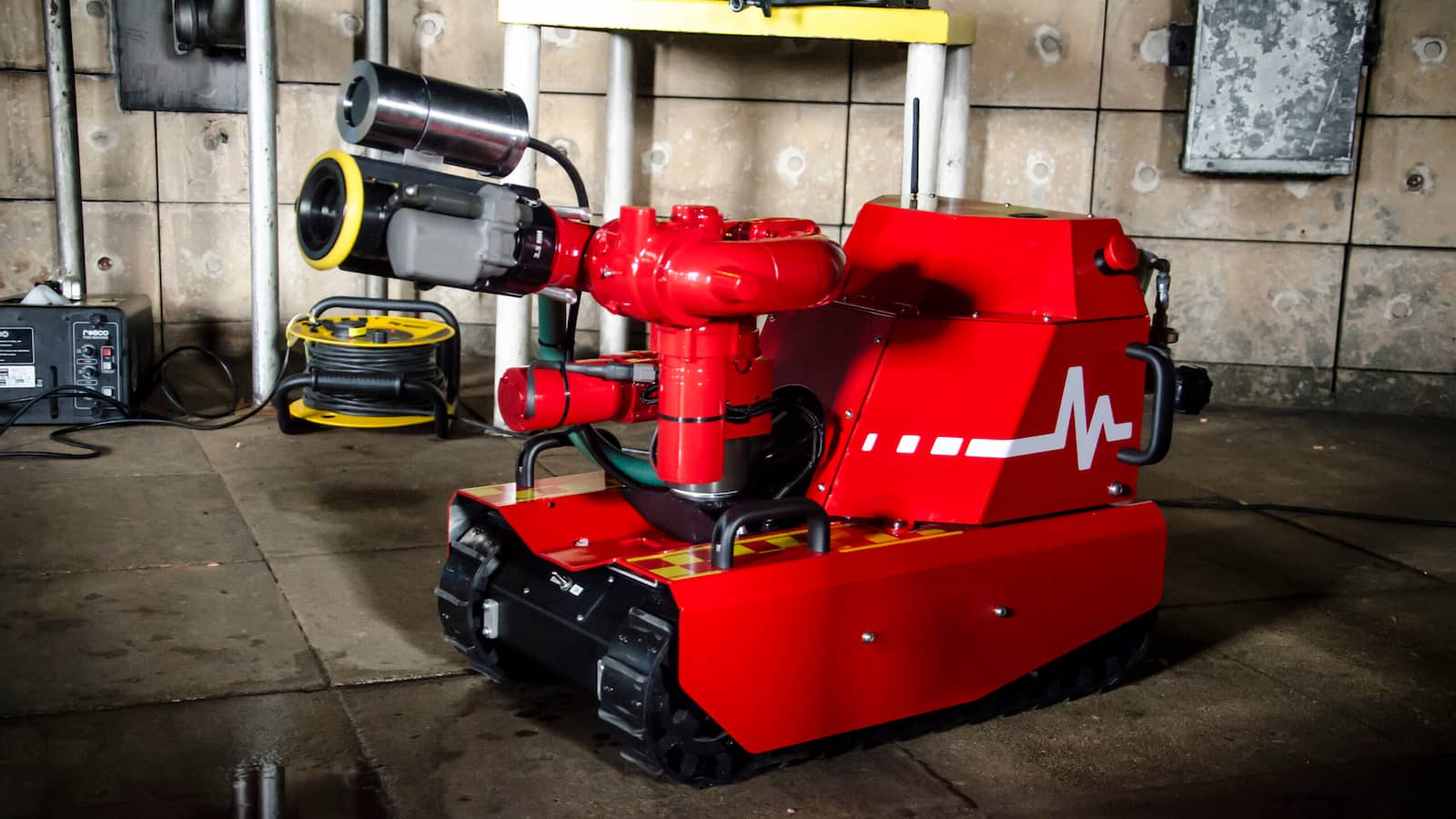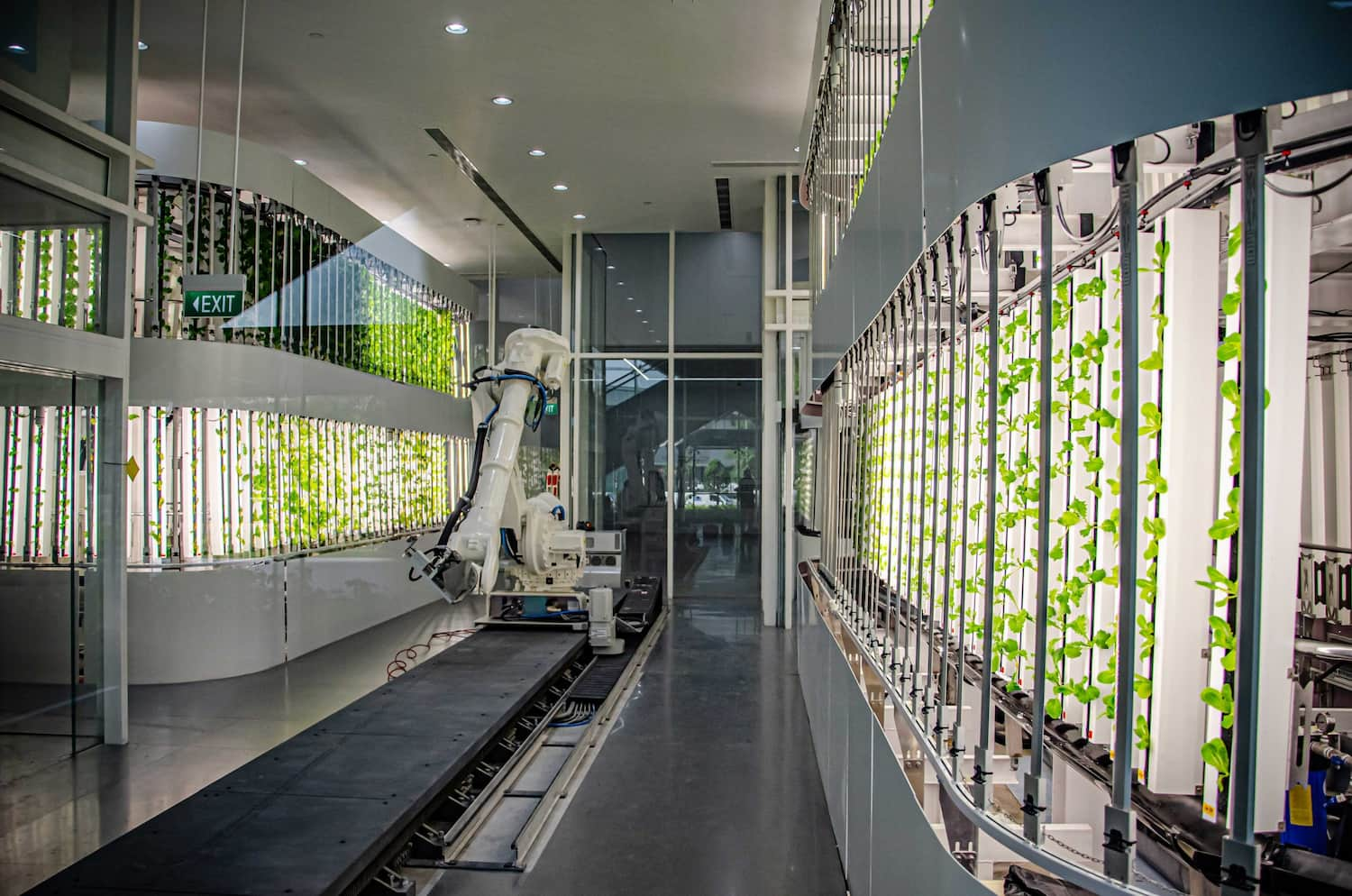Hope Technik's Mission–Ready Drones

Photo of the HOPE Technik team and drones, courtesy of the Ministry of Communications and Information (MCI).
Many would agree that this year’s National Day Parade (NDP) was a sight to behold, with floating ‘buildings’, pyrotechnics and even a flying, glittering mythical creature.
One of NDP’s most visually striking acts was one that celebrated the future; after all, this year’s theme was ‘Building Our Singapore of Tomorrow’. This meant a grand spectacle of neon-lit dancers, flashing laser lights and lively music.
Eagle-eyed audience members would have probably realised that the larger-than-life ‘atoms’ that buzzed over the heads of the dancers were, in fact, drones.
HOPE Technik: Developing Robots and Tools for Firefighting and more

HOPE Technik’s Firefighting Robot is used to fight fire in dangerous situations where it is unsafe for firefighters. Image taken from HOPE Technik.
These drones were developed by HOPE Technik, a homegrown tech company specialising in high-performance engineering. It is founded and staffed by a team of mechanical, electrical and software engineers.
Indeed, you may be more familiar with HOPE Technik’s Red Rhino product, well known as the Singapore Civil Defence Force’s light fire attack vehicle that was converted from a regular pickup truck. The vehicle can manoeuvre tight spots in HDB estates to help fight fires or free trapped victims.
During his 2016 National Day Rally Speech, Prime Minister Lee Hsien Loong highlighted HOPE Technik and its contract with Airbus as an example of how a local firm has used technology to improve the operations of its clients within and outside Singapore.
The Dance of HOPE Technik’s Drifting Drones
But back to the NDP.
As non-human performers in this year’s NDP, HOPE Technik’s drones enjoyed their moment in the limelight, in front of the entire nation.
Getting them parade-ready took some serious tinkering, however. The effort was led by Mindef’s Future Systems Technology Directorate which provided system-of-systems project management.
“Eight unmanned ground vehicles (UGVs) drove into the parade grounds and when they were in position, each one launched an unmanned aerial vehicle (UAV). The UAVs were tethered to the UGVs for safety reasons, and also to run the ‘hardened’ communications link to ensure other radio frequencies could not interfere with the system,” said Mr Peter Ho, Chief Executive Officer of HOPE Technik.
The drones’ involvement in the parade also came with a unique set of challenges, according to Mr Ho.
Firstly, the team had to find a way to give the robots their location, as GPS does not work indoors.
To complicate things further, the UAV had to land back onto the UGV on its own, requiring accuracy down to the centimetre.
This was achieved in collaboration with Temasek Laboratories at the National University of Singapore, whose researchers have deep-dive expertise in core UAV technologies.
It was a complex operation that required military precision and with Murphy’s Law (i.e. anything that can go wrong will go wrong) waiting to strike anytime.
The end result: A smooth, enjoyable performance that did not even hint at the frenetic, behind-the-scenes activity beforehand.
“We had to be flying at exactly 1944 hours on 9 August. There was no room for negotiations or delays. This meant that the system had to be reliable and extremely consistent in its performance,” Mr Ho noted.
“We had one shot. We were not going to miss it. And after months of hard work, we did not miss it!”
HOPE Technik are Engineering Commandoes
The drones that made their debut at NDP are part of an array of versatile unmanned robots and vehicles that form HOPE Technik’s lineup.
From special vehicle operations, or vehicles engineered for special applications, to industrial robots and bespoke solutions, the firm “takes technology and mixes it up with innovation to deliver global products”, as Mr Ho describes.

Robots developed for indoor farming automation. Image taken from HOPE Technik.
“Besides the typical surveillance roles, we also develop special drones for the likes of the Maritime and Port Authority of Singapore, where the drone takes off and lands in the sea, with power coming from its tether for unlimited flight time,” explains Mr Ho.
There are also drones with special devices to carry out building and metal structure inspections, and UAV-UGV systems that are currently being tested to do stock-taking in warehouses.
Working closely with clients to deliver bespoke solutions is perhaps a key factor to HOPE Technik’s success, even if it means creating something new each time.
Describing the HOPE Technik businesses as “tool makers”, Mr Ho believes that this is different from being a bunch of engineers that build whatever they want to, assuming that it is what their clients want.
“We build tech to make things better for our clients; they hold an infinite knowledge of what they need, of how things really need to be.”
A good example of this is the Sesto automated guided vehicle (AGV), a next-generation AGV powered by a high-precision laser-based navigation system.
Equipped with cutting-edge technology and planning capability, this driverless and fully autonomous system takes heavy lifting out of the equation by carrying objects around confined spaces. With Sesto, the company plans to tackle the logistics, semiconductor and hospital sectors.
Despite its successes, the team is certainly not resting on its laurels.
“As a group, we are inching towards our 500th contract delivery which, in our ten-year history, means just about one a week,” Mr Ho added.
“The various product lines will be deployed in close to 20 countries by year-end — and we should be having one heck of a party at the end of the year!”
HOPE Technik is housed in a striking black building in an unassuming industrial estate in Singapore, and the lobby in their office welcomes visitors with a list of Ten Commandments.
The company’s can-do attitude is best summed up by the second one: “We
are engineering commandos. Small in number, strong in force”.


